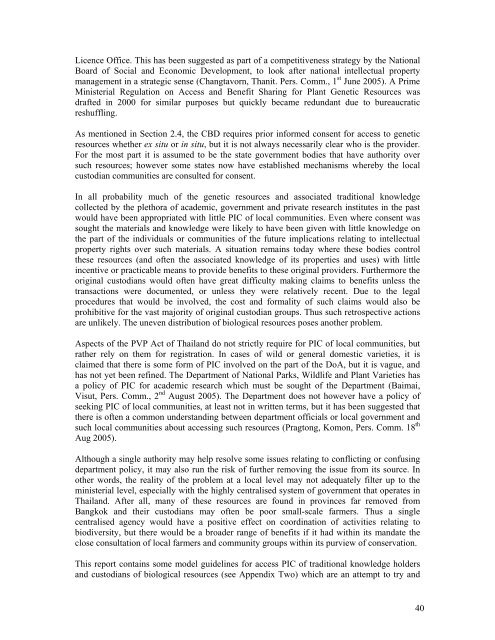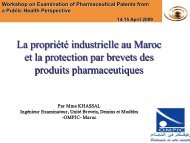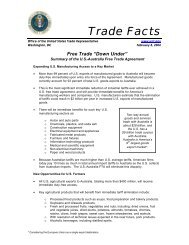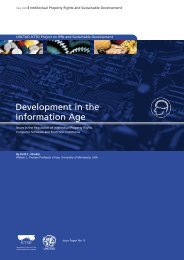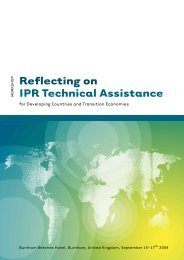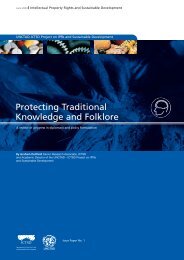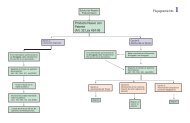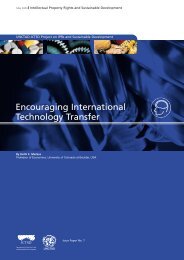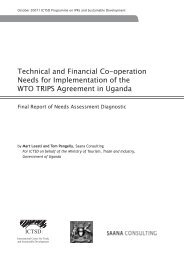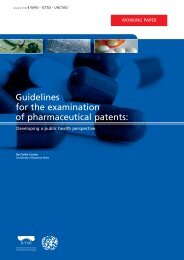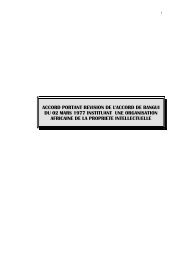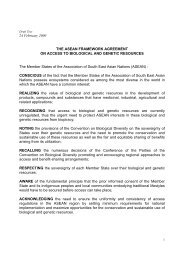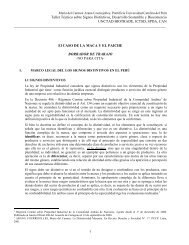Governance and Micropolitics of Traditional ... - IPRsonline.org
Governance and Micropolitics of Traditional ... - IPRsonline.org
Governance and Micropolitics of Traditional ... - IPRsonline.org
You also want an ePaper? Increase the reach of your titles
YUMPU automatically turns print PDFs into web optimized ePapers that Google loves.
Licence Office. This has been suggested as part <strong>of</strong> a competitiveness strategy by the National<br />
Board <strong>of</strong> Social <strong>and</strong> Economic Development, to look after national intellectual property<br />
management in a strategic sense (Changtavorn, Thanit. Pers. Comm., 1 st June 2005). A Prime<br />
Ministerial Regulation on Access <strong>and</strong> Benefit Sharing for Plant Genetic Resources was<br />
drafted in 2000 for similar purposes but quickly became redundant due to bureaucratic<br />
reshuffling.<br />
As mentioned in Section 2.4, the CBD requires prior informed consent for access to genetic<br />
resources whether ex situ or in situ, but it is not always necessarily clear who is the provider.<br />
For the most part it is assumed to be the state government bodies that have authority over<br />
such resources; however some states now have established mechanisms whereby the local<br />
custodian communities are consulted for consent.<br />
In all probability much <strong>of</strong> the genetic resources <strong>and</strong> associated traditional knowledge<br />
collected by the plethora <strong>of</strong> academic, government <strong>and</strong> private research institutes in the past<br />
would have been appropriated with little PIC <strong>of</strong> local communities. Even where consent was<br />
sought the materials <strong>and</strong> knowledge were likely to have been given with little knowledge on<br />
the part <strong>of</strong> the individuals or communities <strong>of</strong> the future implications relating to intellectual<br />
property rights over such materials. A situation remains today where these bodies control<br />
these resources (<strong>and</strong> <strong>of</strong>ten the associated knowledge <strong>of</strong> its properties <strong>and</strong> uses) with little<br />
incentive or practicable means to provide benefits to these original providers. Furthermore the<br />
original custodians would <strong>of</strong>ten have great difficulty making claims to benefits unless the<br />
transactions were documented, or unless they were relatively recent. Due to the legal<br />
procedures that would be involved, the cost <strong>and</strong> formality <strong>of</strong> such claims would also be<br />
prohibitive for the vast majority <strong>of</strong> original custodian groups. Thus such retrospective actions<br />
are unlikely. The uneven distribution <strong>of</strong> biological resources poses another problem.<br />
Aspects <strong>of</strong> the PVP Act <strong>of</strong> Thail<strong>and</strong> do not strictly require for PIC <strong>of</strong> local communities, but<br />
rather rely on them for registration. In cases <strong>of</strong> wild or general domestic varieties, it is<br />
claimed that there is some form <strong>of</strong> PIC involved on the part <strong>of</strong> the DoA, but it is vague, <strong>and</strong><br />
has not yet been refined. The Department <strong>of</strong> National Parks, Wildlife <strong>and</strong> Plant Varieties has<br />
a policy <strong>of</strong> PIC for academic research which must be sought <strong>of</strong> the Department (Baimai,<br />
Visut, Pers. Comm., 2 nd August 2005). The Department does not however have a policy <strong>of</strong><br />
seeking PIC <strong>of</strong> local communities, at least not in written terms, but it has been suggested that<br />
there is <strong>of</strong>ten a common underst<strong>and</strong>ing between department <strong>of</strong>ficials or local government <strong>and</strong><br />
such local communities about accessing such resources (Pragtong, Komon, Pers. Comm. 18 th<br />
Aug 2005).<br />
Although a single authority may help resolve some issues relating to conflicting or confusing<br />
department policy, it may also run the risk <strong>of</strong> further removing the issue from its source. In<br />
other words, the reality <strong>of</strong> the problem at a local level may not adequately filter up to the<br />
ministerial level, especially with the highly centralised system <strong>of</strong> government that operates in<br />
Thail<strong>and</strong>. After all, many <strong>of</strong> these resources are found in provinces far removed from<br />
Bangkok <strong>and</strong> their custodians may <strong>of</strong>ten be poor small-scale farmers. Thus a single<br />
centralised agency would have a positive effect on coordination <strong>of</strong> activities relating to<br />
biodiversity, but there would be a broader range <strong>of</strong> benefits if it had within its m<strong>and</strong>ate the<br />
close consultation <strong>of</strong> local farmers <strong>and</strong> community groups within its purview <strong>of</strong> conservation.<br />
This report contains some model guidelines for access PIC <strong>of</strong> traditional knowledge holders<br />
<strong>and</strong> custodians <strong>of</strong> biological resources (see Appendix Two) which are an attempt to try <strong>and</strong><br />
40


